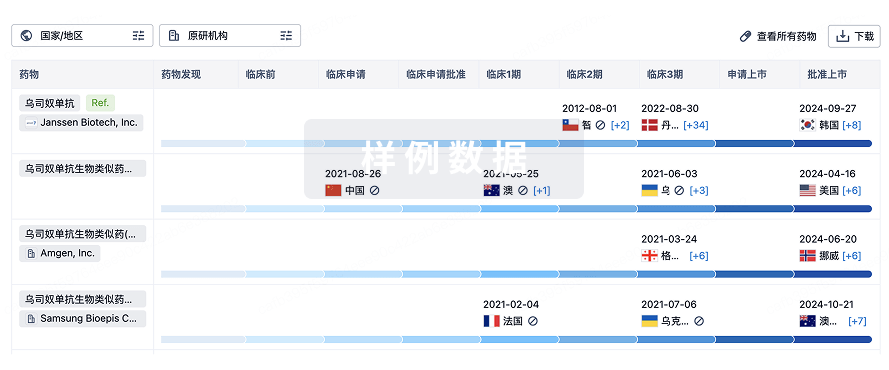预约演示
更新于:2025-08-23
Amylin (Orion)
更新于:2025-08-23
概要
基本信息
非在研机构- |
权益机构- |
最高研发阶段药物发现 |
首次获批日期- |
最高研发阶段(中国)- |
特殊审评- |
关联
100 项与 Amylin (Orion) 相关的临床结果
登录后查看更多信息
100 项与 Amylin (Orion) 相关的转化医学
登录后查看更多信息
100 项与 Amylin (Orion) 相关的专利(医药)
登录后查看更多信息
726
项与 Amylin (Orion) 相关的文献(医药)2025-12-31·ANNALS OF MEDICINE
Amylin inhibits gastric cancer progression by targeting CCN1 and affecting the PI3K/AKT signalling pathway
Article
作者: Liu, Li ; Liu, Wenxuan ; Deng, Wenhong
METHODS:
This study used a combination of in vitro and in vivo experiments to investigate the role of amylin in the progression of GC. The expression of amylin in GC and its clinical correlation were evaluated using 38 pairs of GC and healthy human clinical samples. In vitro studies, human GC cell lines were treated with amylin to evaluate the effects of amylin on the proliferation, apoptosis and migration of GC cells. In in vivo studies, xenograft mouse models were established by subcutaneous injection of GC cells into nude mice, followed by treatment with amylin to assess tumor growth. Finally, Next-Generation Sequencing Technology (RNA-seq) was used to explore the potential mechanism of amylin on GC.
RESULTS:
We found that amylin expression was reduced in GC compared to adjacent normal gastric tissues and that elevated amylin expression was negatively correlated with adverse pathological factors (p < 0.05). Additionally, we demonstrated that amylin impeded the growth, invasion, migration, and colony formation of GC cells and suppressed the epithelial-to-mesenchymal transformation of these cells (p < 0.05). Tumour xenograft model experiments confirmed the tumour-suppressive effect of amylin in subcutaneous tumours in nude mice (p < 0.05). Transcriptome sequencing (RNA-seq) revealed that amylin significantly down-regulated CCN1 gene expression in GC cells (p < 0.001). Further intervention targeting CCN1 verified its significance as a target of amylin's anti-carcinogenic function in GC. Additionally, Kyoto Encyclopedia of Genes and Genomes (KEGG) pathway enrichment analysis revealed that amylin exerted its oncogenic effects by inhibiting the PI3K/Akt signalling pathway (p < 0.05).
CONCLUSIONS:
Our findings demonstrate that amylin plays a crucial role in suppressing gastric cancer progression by targeting CCN1 and inhibiting the PI3K/Akt signalling pathway. These results suggest that amylin could serve as a potential therapeutic agent for GC treatment.
2025-11-01·NEUROPHARMACOLOGY
Role of amylin in feeding and satiation
Review
作者: Lutz, Thomas A
This article summarizes the key literature describing the effects of the pancreatic beta-cell hormone amylin on eating. One of the first described and best investigated effects of amylin on eating is its physiological effect to control meal size by inducing satiation. This effect is very rapid, short-lasting and probably directly reflects the meal-induced increase in circulating amylin levels. Evidence provided by many groups suggests that the effect of amylin on eating is directly mediated by humoral action in the central nervous system rather than by peripheral receptors. It is also clear that the caudal hindbrain, in particular the area postrema, is a key brain region mediating amylin effects, but amylin may also act at different sites in the brain. The latter is particularly true for the effect of amylin to reduce food reward. Hence, amylin not only reduces caloric intake as such but may specifically reduce high fat intake, at least in certain experimental conditions; in people, amylin receptor agonists have been shown to reduce the number of binge eating episodes. In recent years, long-lasting amylin receptor agonists have been developed. Alone or in combination with other gut hormone receptor agonists (in particular the agonist of glucagon-like peptide-1 [GLP-1] receptor, semaglutide), these molecules turned out to be highly promising therapeutic agents for the treatment of obesity.
2025-09-01·DIABETES OBESITY & METABOLISM
The effects of anti‐obesity medications on bone metabolism: A critical appraisal
Review
作者: Polyzos, Stergios A. ; Paccou, Julien ; Palermo, Andrea ; Anastasilakis, Athanasios D.
Abstract:
The development of novel sophisticated medications that induce weight loss has revolutionized the management of people living with obesity (PwO). However, when body weight is reduced, muscle and bone are lost along with fat. In the present review, we quote and discuss existing evidence on the effects of the major anti‐obesity medications on bone metabolism. Glucagon‐like peptide‐1 receptor (GLP‐1R) agonists have shown a positive impact in preclinical studies but a neutral or negative, albeit not clinically significant, effect on bone turnover markers and bone mineral density in clinical studies. Nevertheless, fracture risk does not seem to increase with GLP‐1R agonists use, at least in clinically relevant doses. Limited, mostly preclinical, data suggest that other incretin analogues, including dual GLP‐1R and glucose‐dependent insulinotropic polypeptide (GIP) receptor (GIPR) agonists, dual GLP‐1R and glucagon receptor (GCGR) agonists, and triple GLP‐1R, GIPR and GCGR agonists, may have a positive effect on bone. Preclinical data with amylin analogues imply the same. Activin type II receptor (ActRII) antagonists may combine anti‐obesity effects with simultaneous muscle and bone mass preservation and could be used either as monotherapy or in combination with incretin analogues. The bone effects of opioid receptor antagonists and setmelanotide are largely unknown, while the impact of the combination of phentermine with topiramate is assumed to be negative. Finally, very limited clinical evidence suggests that orlistat may have a neutral effect on bone metabolism.
30
项与 Amylin (Orion) 相关的新闻(医药)2025-03-13
·医药笔记
▎Armstrong
近几年来,减重适应症的拓展,彻底打开了GLP-1类药物的想象空间,对于GLP-1伴侣的追寻也在如火如荼的进行中。礼来的GLP-1/GIP已经获批上市,GLP-1/GIP/GCG也推进到三期临床阶段。丹麦诺和诺德则将重心放在胰淀素Amylin上面,包括Amylin与司美格鲁肽联用,糖尿病、减重三期临床已经获得顶线数据,GLP-1/Amylin双靶点的Amycretin也在初步临床中表现出极具竞争力的疗效。1.25mg、5mg、20mg剂量组治疗36周分别减重9.7%、16.2%、22.0%,安慰剂组减重2.0%左右,安慰剂校正后,20mg高剂量组治疗36周减重幅度达到20.0%。
诺和诺德完成POC之后,越来越多的MNC开始积极布局胰淀素Amylin。2025年3月3日,艾伯维宣布引进丹麦生物技术公司Gubra的Amylin类似物GUB014295,根据协议,艾伯维支付3.5亿美元预付款,18.75亿美元里程碑金额,以及一定比例的销售分成。
GUB014295为Gubra的核心管线,为一款同时激活胰淀素受体和降钙素受体的多肽药物,目前处于一期临床阶段。
2025年3月12日,罗氏宣布与Zealand达成合作,共同开发胰淀素类似物Petrelintide。
根据协议,罗氏支付16.5亿美元预付款、12亿美元开发里程碑金额以及24亿美元销售里程碑金额,协议总金额高达53亿美元。
Petrelintide为一款长效、中性可溶的胰淀素类似物,目前处于二期临床阶段。
总结
同为丹麦企业,诺和诺德、Zealand、Gubra又同时重点布局了胰淀素项目,诺和诺德引领了胰淀素赛道的竞争,Gubra、Zealand陆续完成胰淀素项目为核心的数十亿美元授权合作交易。
Armstrong技术全梳理系列
GPRC5D靶点全梳理;
CD40靶点全梳理;
CD47靶点全梳理;
补体靶向药物技术全梳理;
补体药物:眼科治疗的重要方向;
Claudin 6靶点全梳理;
Claudin 18.2靶点全梳理;
靶点冷暖,行业自知;
中国大分子新药研发格局;
被炮轰的“me too”;
佐剂百年史;
胰岛素百年传奇;
CUSBEA:风雨四十载;
中国新药研发的焦虑;
中国生物医药企业的研发竞争;
中国双抗竞争格局;
中国ADC竞争格局;
中国双抗技术全梳理;
中国ADC技术全梳理;
Ambrx技术全梳理;
Vir Biotech技术全梳理;
Immune-Onc技术全梳理;
亘喜生物技术全梳理;
康哲药业技术全梳理;
科济药业技术全梳理;
恺佧生物技术全梳理;
同宜医药技术全梳理;
百奥赛图技术全梳理;
腾盛博药技术全梳理;
创胜集团技术全梳理;
永泰生物技术全梳理;
中国抗体技术全梳理;
德琪医药技术全梳理;
德琪医药技术全梳理2.0;
和铂医药技术全梳理;
荣昌生物技术全梳理;
再鼎医药技术全梳理;
药明生物技术全梳理;
恒瑞医药技术全梳理;
豪森药业技术全梳理;
正大天晴技术全梳理;
吉凯基因技术全梳理;
基石药业技术全梳理;
百济神州技术全梳理;
百济神州技术全梳理第2版;
信达生物技术全梳理;
信达生物技术全梳理第2版;
中山康方技术全梳理;
复宏汉霖技术全梳理;
先声药业技术全梳理;
君实生物技术全梳理;
嘉和生物技术全梳理;
志道生物技术全梳理;
道尔生物技术全梳理;
尚健生物技术全梳理;
康宁杰瑞技术全梳理;
科望医药技术全梳理;
科望医药技术全梳理2.0;
岸迈生物技术全梳理;
礼进生物技术全梳理;
康桥资本技术全梳理;
余国良的抗体药布局;
荃信生物技术全梳理;
安源医药技术全梳理;
三生国健技术全梳理;
仁会生物技术全梳理;
乐普生物技术全梳理;
同润生物技术全梳理;
宜明昂科技术全梳理;
派格生物技术全梳理;
迈威生物技术全梳理;
Momenta技术全梳理;
NGM技术全梳理;
普米斯生物技术全梳理;
普米斯生物技术全梳理2.0;
三叶草生物技术全梳理;
贝达药业抗体药全梳理;
泽璟制药抗体药全梳理;
恒瑞医药抗体药全梳理;
齐鲁制药抗体药全梳理;
石药集团抗体药全梳理;
豪森药业抗体药全梳理;
华海药业抗体药全梳理;
科伦药业抗体药全梳理;
百奥泰技术全梳理;
凡恩世技术全梳理。
临床3期引进/卖出临床2期临床1期上市批准
2025-03-12
Zealand Pharma has finally found a partner. And according to the Danish company, the licensing deal it announced with Roche on Wednesday for its amylin analog petrelintide is the biggest ever for an obesity candidate to date.
The companies
said
the Swiss pharma is paying Zealand $1.65 billion upfront in cash. $1.4 billion of that will be given once the deal is closed, which is expected to be in the second quarter of this year, and $250 million over the next two years every time the partnership celebrates an anniversary.
Importantly, Roche and Zealand will also investigate petrelintide combinations. The first on the list for co-administration is Roche’s GLP-1/GIP agonist candidate CT-388, which Roche obtained from its acquisition of Carmot Therapeutics in late 2023.
CT-388 has shown effectiveness
in early trials
but had high rates of gastrointestinal side effects; combining it with amylin could allow a more potent weight loss effect, allowing lower, safer doses.
The ghost at the feast is Novo Nordisk’s amylin-incretin combo CagriSema, which has disappointed in late-stage trials in patients
with obesity
and
with obesity and diabetes
. CEO Adam Steensberg told
Endpoints News
in an interview that Zealand can do better.
CagriSema combines equal 2.4 mg doses of Novo’s amylin analog cagrilintide and GLP-1 semaglutide, and Steensberg suggests this ratio is “suboptimal.” “We think you need to max out on amylin … then just add a little bit of GLP-1/GIP on top,” he said.
In Zealand’s ongoing Phase 2b monotherapy trial in obese patients, petrelintide is being
dosed at up to 9 mg
. Data from this trial are due by mid-2026.
Steensberg said that having Roche on board as a partner does not alter its plans for Phase 3 trials of petrelintide, but could accelerate them. “We look very much forward to also having their input into the details of the program,” he said.
“The key focus will be on obesity as a first indication, with an ambition of rapidly expanding into additional indications,” Steensberg said. These are yet to be confirmed, but he did not rule out research in diabetes and the liver disorder MASH.
Zealand believes that petrelintide monotherapy and the incretin combo will eventually be used to treat different populations. The former “will be a product for the majority of obese individuals,” Steensberg said, whereas “the most morbidly obese patients, they could benefit from a combination therapy.” The combo could also be of use in patients with both obesity and type 2 diabetes.
On Zealand’s side, the collaboration is strictly on petrelintide — its other obesity candidates, such as the GLP-1/GLP-2 drug dapiglutide, are not involved. But other injected Roche assets might be used in future combinations, Steensberg said.
Roche’s weight loss portfolio mainly stems from its $2.7 billion
acquisition
of Carmot. Roche has another GLP-1/GIP agonist, CT-868, and one of the brightest oral obesity hopes, a pill called CT-996. The company also has an anti-latent myostatin product called GYM329.
Including milestone payments, the companies estimate the deal to be worth up to $5.3 billion. As part of the deal, Zealand will pay Roche $350 million for its share in studying CT-388 as a combo with petrelintide.
The companies said they will split revenues — and losses — on their first monotherapy and combo drugs on a “50/50 basis” in the US and Europe. Steensberg described the profit share as the “true value” of the deal. Zealand could get royalties on net sales in other countries.
Another major aspect of this deal is Roche’s manufacturing network and commercial reach. With the leading weight loss drug companies Eli Lilly and Novo Nordisk having to find ways to scale up manufacturing quickly, others yet to enter the market are mapping out
commercial production plans
much earlier in the process.
Zealand has not been shy in declaring it was looking for a partner to study and commercialize its lead weight loss candidate. It has been on the hunt for a year or so now, and three weeks ago Steensberg
told Endpoints
the biotech was “exactly where we want to be.”
Zealand is
up
35% on the Danish stock exchange.
Additional reporting by Reynald Castaneda.
Editor’s note: This article has been updated throughout after an interview with Zealand CEO Adam Steensberg and stock reaction.
临床2期引进/卖出并购
2025-03-11
1. 科伦博泰TROP2 ADC获批肺癌适应症,全球首款
3月10日,中国国家药监局(NMPA)官网最新公示,科伦博泰靶向TROP2的抗体偶联药物(ADC)注射用芦康沙妥珠单抗的新适应症上市申请已获得批准。这是该产品在中国的第二项NDA申请,此前已经被CDE纳入优先审评,具体适应症为:用于经表皮生长因子受体酪氨酸激酶抑制剂(EGFR-TKI)和含铂化疗治疗失败的局部晚期或转移性EGFR突变非小细胞肺癌成人患者。此前非小细胞肺癌中,目前还没有一款TROP-2 ADC药物获批上市,吉利德的三期临床已经失败,第一三共则基于亚组分析在美国递交了上市申请,仍在审评中。
2. 辉瑞CD3/BCMA双抗在华获批上市
3月10日,辉瑞宣布CD3/BCMA双抗埃纳妥单抗(Elranatamab,商品名:易瑞欧)获国家药监局附条件批准上市,用于治疗既往接受过至少三种治疗(含一种蛋白酶体抑制剂、一种免疫调节剂和一种抗CD38单克隆抗体)的复发或难治性多发性骨髓瘤(R/R MM)成人患者。此次批准主要是基于单臂II期MagnetisMM-3研究以及中国单独的Ib/II期单臂研究MagnetisMM-8研究的积极数据。MagnetisMM-3研究结果显示,接受过多线治疗的R/R MM患者接受埃纳妥单抗治疗后,中位总生存期(mOS)为24.6个月,中位无进展生存期(mPFS)为17.2个月。此外,中位随访33.9个月时,患者的中位缓解持续时间(mDOR)仍未达到,DOR达到30个月的患者比例为61.0%。
3. 阿斯利康两款新药在华获批新适应症
3月10日,国家药监局官网显示,阿斯利康的本瑞利珠单抗(Benralizumab)和度伐利尤单抗(Durvalumab)分别获批新适应症。根据阿斯利康2024年报和临床试验进展,推测本瑞利珠单抗此次获批治疗6-11岁嗜酸性粒细胞表型重度哮喘患者,度伐利尤单抗此次获批围手术期治疗非小细胞肺癌(NSCLC)。2024年3月,本瑞利珠单抗治疗儿童嗜酸性粒细胞性哮喘的III期TATE研究数据发布。基于TATE研究的积极数据,本瑞利珠单抗已在2024年4月获得FDA批准用于作为6-11岁儿童嗜酸性粒细胞性哮喘患者的附加维持治疗。2024年8月,阿斯利康在WCLC 2024大会上公布了度伐利尤单抗围手术期治疗NSCLC的III期AEGEAN研究最新数据。基于AEGEAN研究的初次积极数据,度伐利尤单抗已在2024年8月获得FDA批准用于围手术期治疗无已知EGFR突变或ALK重排的可切除的早期(IIA-IIIB)NSCLC患者。
4. 艾伯维IL-23抑制剂「利生奇珠单抗」在华获批上市
3月10日,艾伯维宣布利生奇珠单抗(risankizumab,商品名:喜开悦)在华获批上市,用于治疗对传统治疗或生物制剂治疗应答不足、失应答或不耐受的中重度活动性克罗恩病成年患者。此次获批包括利生奇珠单抗注射液与利生奇珠单抗注射液(皮下注射)两种剂型。这是全球首个获批用于中重度活动性克罗恩病成人患者的IL-23抑制剂,获批后也是国内首个拥有随身给药器的IL-23抑制剂。
5. 翰森制药三代EGFR-TKI「阿美替尼」获批新适应症
3月10日,NMPA官网最新公示,翰森制药三代EGFR-TKI甲磺酸阿美替尼片的新适应症上市申请获得批准。根据公开资料,该药本次获批的适应症为:用于含铂根治性放化疗后未出现疾病进展的不可切除的局部晚期表皮生长因子受体(EGFR)外显子19缺失或外显子21(L858R)置换突变的非小细胞肺癌(NSCLC)患者治疗。在该适应症上,阿美替尼片此前已经被CDE纳入突破性治疗品种和优先审评。作为一款第三代EGFR-TKI,阿美替尼片曾先后于2020年和2021年在中国获批,分别用于二线治疗既往经EGFR-TKI治疗进展,且T790M突变阳性的局部晚期或转移性NSCLC患者,和一线治疗具有EGFR外显子19缺失或外显子21(L858R)置换突变阳性的局部晚期或转移性NSCLC成人患者。
6. 同源康医药TY-9591头对头击败奥希替尼,拟报上市
3月9日,同源康医药发布公告,TY-9591在关键二期临床中头对头对比奥希替尼一线治疗EGFR突变脑转移NSCLC显示统计学显著意义和重大临床获益。iORR达到预期目的,TY-9591对比奥希替尼显示出统计学意义和临床意义的明显改善。同源康医药将在近期递交上市申请。TY-9591通过氘代对奥希替尼进行改良以提高安全性,允许更大的给药剂量,从而可能提高药效。
7. 诺和诺德公布司美格鲁肽+Amylin糖尿病合并肥胖三期临床数据
3月10日,诺和诺德公布司美格鲁肽+Amylin类似物Cagrilintide联合治疗二型糖尿病合并肥胖患者三期临床REDEFINE 2的顶线数据。经过68周治疗,61.9%的患者达到的最高剂量,治疗组减重15.7%,安慰剂组减重3.1%,安慰剂校正后减重12.6%,两组减重幅度超过5%的患者比例分别为89.7%、30.3%。消息发布后,诺和诺德股价盘前大跌6%,目前市值为3640亿美元。诺和诺德将下一代的减重药物中心放在Amylin上,但司美格鲁肽+Amylin联合治疗数据不达预期,而GLP-1/Amylin双靶点激动剂则有望媲美三靶点GGG产品,随着这两款产品的顶线数据陆续发布,诺和诺德的股价也迎来股价的剧烈波动。
1. 3.55亿美元!印度Sun Pharma收购Checkpoint Therapeutics
3月10日,印度太阳制药(Sun Pharma)表示,将收购位于美国的免疫疗法和靶向肿瘤治疗公司Checkpoint Therapeutics,交易价值高达 3.55 亿美元。Sun Pharma 将支付每股 4.1 美元的预付现金,总对价为 3.55 亿美元。股东还将在实现里程碑时获得每股最高 0.7 美元的或有价值权。该交易预计将于 2025 年第二季度完成。Checkpoint 拥有一款已获美国 FDA 批准上市的抗 PD-L1 单克隆抗体 Cosibelimab。
内容来源于网络,如有侵权,请联系删除。

抗体药物偶联物临床结果合作
100 项与 Amylin (Orion) 相关的药物交易
登录后查看更多信息
研发状态
10 条进展最快的记录, 后查看更多信息
登录
| 适应症 | 最高研发状态 | 国家/地区 | 公司 | 日期 |
|---|---|---|---|---|
| 代谢性疾病 | 药物发现 | 加拿大 | 2025-02-01 |
登录后查看更多信息
临床结果
临床结果
适应症
分期
评价
查看全部结果
| 研究 | 分期 | 人群特征 | 评价人数 | 分组 | 结果 | 评价 | 发布日期 |
|---|
No Data | |||||||
登录后查看更多信息
转化医学
使用我们的转化医学数据加速您的研究。
登录
或

药物交易
使用我们的药物交易数据加速您的研究。
登录
或

核心专利
使用我们的核心专利数据促进您的研究。
登录
或

临床分析
紧跟全球注册中心的最新临床试验。
登录
或

批准
利用最新的监管批准信息加速您的研究。
登录
或

生物类似药
生物类似药在不同国家/地区的竞争态势。请注意临床1/2期并入临床2期,临床2/3期并入临床3期
登录
或

特殊审评
只需点击几下即可了解关键药物信息。
登录
或

Eureka LS:
全新生物医药AI Agent 覆盖科研全链路,让突破性发现快人一步
立即开始免费试用!
智慧芽新药情报库是智慧芽专为生命科学人士构建的基于AI的创新药情报平台,助您全方位提升您的研发与决策效率。
立即开始数据试用!
智慧芽新药库数据也通过智慧芽数据服务平台,以API或者数据包形式对外开放,助您更加充分利用智慧芽新药情报信息。
生物序列数据库
生物药研发创新
免费使用
化学结构数据库
小分子化药研发创新
免费使用
